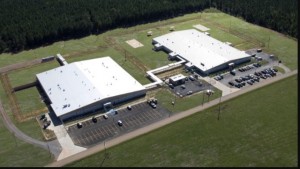600 Bed Regional Jail Discussed by 5 County Judges
August 8th, 2017 by iPhone Five county judges from southeast Arkansas met with state representative Jeff Wardlaw, Thursday to discuss a possible 600-bed facility that has been described as a regional jail, but also as a privately owned prison.
Five county judges from southeast Arkansas met with state representative Jeff Wardlaw, Thursday to discuss a possible 600-bed facility that has been described as a regional jail, but also as a privately owned prison.
Drew and Bradley Counties are fully on board with the project, while Chicot, Lincoln and Cleveland Counties are interested, but haven’t obligated themselves, yet.
The facility would hold 500 state inmates, with around 100 beds serving the local participating counties.
Judge Akin told reporters that Bowie County, Texas holds approximally 300 Arkansas prisoners, that would be transferred to the proposed Wilmar facility. This would provide Arkansas jobs, to local residents. 50 beds would be expected to hold parole/probation violators. The remaining 100 beds would be used to house inmates from Southeast Arkansas counties.
State officials have stated that this facility would not include maximum-security prisoners.
Judge Akin continued, “Drew County has a 43-bed jail and spends $60 a day to hold each inmate.
It comes down to dollars and cents. With 600 inmates, instead of 40, their buying power becomes like Walmart or Amazon, for buying food and supplies.”
Currently there is no jail in Bradley County, who transport their inmates to Ashley County. Cleveland County currently has a very small, very old jail in their courthouse.
It is expected that the private prison operators will ask for a 20-year contract, to construct the facility. Under act 1206 of 2015, a 20 year contract would be allowed by the state.
Several companies have expressed interest in operating the facility, and local officials have toured the LaSalle facility in Ruston, Louisiana.
The “regional jail commission” will take effect when another county becomes involved and appoints their judge/sheriff to the board. A commission must have five members; this group currently only has 4.
Judge Akin described the purpose of the commission as “the middle man” between the state and the contractor.
Representative Wardlaw described his involvement as being based on “counties are having to drive across multiple counties to house inmates,” and “inmates that should be incarcerated or walking free.”
Wardlaw also pointed out that to have the needed number of inmates to make the facility feasible, it would take the counties, as well as the states involvement.
In a separate interview, Judge Akin described the high number of parole and probation violators that are still on the street, due to lack of bed space in the prisons. This was to explain that having more jail bed space could have a significant impact on reducing local crimes.
Choose another article
Newer article: $4,000 Load of Logs, Saturday’s 1st Auction
Older article: Donald Vandyke





























































Why are the sheriffs from these counties not being told of these meetings and involved in this conversation thay involves a part of their job?
We don’t need another jail in Drew County. If those other counties have problems that’s for them to figure out. We need GOOD PAYING JOBS to to this area. You don’t want a CIVIC CENTER but you want a JAIL!!!!!
The Governors Returning Citizens Program from Corrections Facilities with a comprehensive Reentry none existing Program in the 19th Judicial District that would be in partnership with Vocational, Technical, Arkansas Department Workforce Services WIOA returning citizens programs along with Arkansas Works Vocational/Technology Training programs is what the 46th Gubernatorial Administration and the Arkansas General Assembly has passed and placed into law for reduce recidivism of parolees and getting them jobs and training over and above more prisons and incarcerations for the chronic in and out, in and out parolees who have not Second Chance at Life Programs via Faith Base and Community Base Non Profits in the targeted Counties to construct this new Prison/Jail. There needs to be a commission study with Arkansas Reentry Program Entities and establish Returning Citizens Programs prior to building more prison beds for temporary stay and return, return, return.
Putting this in it’s location isn’t a good idea. May need to reconsider it’s location.
If the construction site is near the sport complex, then this is a bad idea. Why would you want any criminals, no mater how small the crime, so close to where our children play?
Also property value will decrease for everyone. The closer you live to any jail or prison, the more the property decreases.
Well, my housing market will go down. I get that these folks need to be in jail, but do I really want 500 convicts right down the road from me? No. Not enough bed space… I got an idea… start actually punishing folks so they won’t be cool with living in prison their whole lives. It’s called DETERENT, and people now don’t care.
Is this really the kind of jobs we want in Drew County? I suggest people read about the private prisons that were supposed to help poor counties iin Colorado. The employees tend to be renters rather than buyers, as many of the workers tend to drift from prison to prison. Petty crime is likely to increase, and if a prisoner escapes, Drew County will get to pick up the law enforcement cost that could easily make Drew County lose money on this venture. As the sports area has moved west of town, and the inter-modal facility is in Wilmar, growth would likely move toward Wilmar as there are adequate utilities. Do we really want to stop positive growth by having a prison? I think the voters should get to vote before a 600 bed prison is put in Wilmar.
Let me begin by saying that while I am a proud member of the UAM faculty, my comments here represent my private thoughts and opinions as a criminal justice expert, and in no way reflect on UAM. I would also like to say that I am not per se against any particular company. I do, however, want to make my fellow residents of Southeast Arkansas aware of some things that we should ask before the decision is made to open such a facility in our communities.
Private corrections is more than a little controversial. Criminal justice is a function of state and local governments, and there are real dangers associated with turning those obligations over to private companies. It is worthy of note that the Federal Government, as represented by the Bureau of Prisons, has largely eliminated the use of private facilities because of these problems. The Department of Justice determined that such facilities were poorly run when compared to Bureau of Prisons facilities, and they tended not to realized the massive savings promised to taxpayers. They also found that there was a greater security risk to both inmates and staff. When private prisons do save the public money, they most often do it by providing lower pay and lower quality benefits to rank and file employees (executives always seem to do well).
We must remember that a private prison (or jail hybrid) is first and foremost a business: The primary purpose of a business to to make a profit. Margins are critically important to businesses, and the way to widen margins in corrections is to skimp on security, staff pay and benefits, and training. As a general rule, private facilities pay their officers less, provide less training, and have higher inmate-to-staff ratios. This tends to result in high staff turnover among officers, and higher rates of inmate assaults. The research literature shows that there are some exceptions to these general rules; this is because some private prisons actually work and do save the taxpayers money. There are also some important benefits that can’t be denied, such as the fact that private entities can construct new facilities faster and cheaper than can be done by government agencies.
A contractual agreement, especially one with a private, profit driven company that will bind the taxpayers for twenty years, should not be entered into lightly. Our elected leaders need to dig deeply into the proposed contracts, and make sure that any promises made on a handshake are also found in those documents. If they lack the necessary expertise in either prison operations or finance, then they should seek out expertise. There is also the issue of legal liability; governments may can contract out government responsibilities, but if inmates are hurt or killed, the government (the taxpayers) are still liable and can be sued for massive damages under Section 1983. Legal counsel should be consulted at every turn to mitigate this public liability. We also need to think about what it means to have 600 inmates in our communities. These man will have families, and these families will want to visit. This may boost the local economy because out of town visitors will spend money. The dark side hundreds of new visitors to our region is that they could bring drugs and other crime and disorder problems with them. It may seem unkind to say, but crime statistics tell us that birds of a feather really do flock together. Law enforcement needs to be assisted in assessing the impact of this and given new funding to deal with potential problems before they happen.
If you want to know more about these issues, I direct you to an important (albeit dated) monograph on the subject prepared by the Bureau of Justice Assistance in 2001: https://www.ncjrs.gov/pdffiles1/bja/181249.pdf
Adam J. McKee, Ph.D.